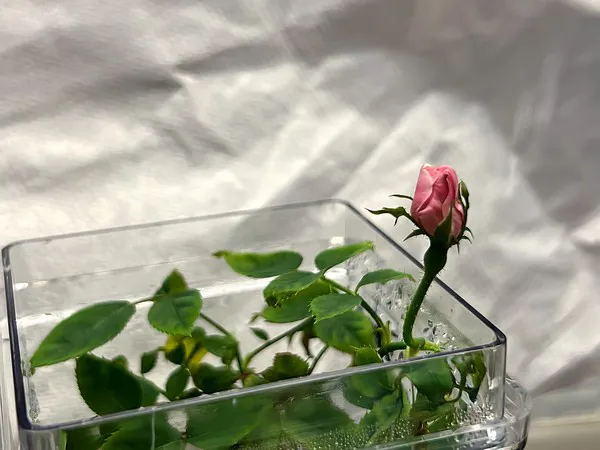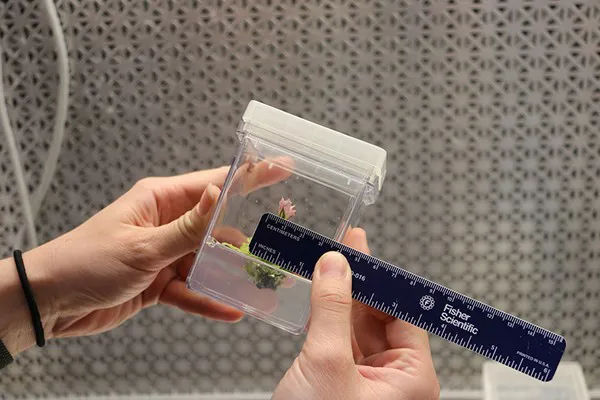Roses are red… and have dozens of cultivated hues. Whatever their colors, they are among the most popular flower throughout the year for many consumers, from long-stemmed Valentine's bouquets and Mother's Day arrangements to a bounty of varieties available for planting in landscapes during the summer and fall.
But the florist favorite faces a host of potential dangers between breeding and bouquet, including rose rosette disease, a mite-borne virus fatal to domestic roses. The rose industry has long sought a solution, and now there may be an answer from a surprising source: micro roses that grew unexpectedly during a research project at the University of Georgia College of Agricultural and Environmental Sciences (CAES).
 One of several micro roses that bloomed in the Wilde lab. Researchers were astounded by the micro blooms; to their knowledge, blooms have never developed from sterilized stem pieces.
One of several micro roses that bloomed in the Wilde lab. Researchers were astounded by the micro blooms; to their knowledge, blooms have never developed from sterilized stem pieces.
Heather Gladfelter, a postdoctoral associate focused on ornamentals and molecular biology in the CAES Department of Horticulture, discovered the micro roses — with blooms barely the size of a pinky nail — while transferring sterile rose shoot clumps from tissue-culture containers to fresh nutrient media.
Researchers were astounded by the micro blooms. To their knowledge, blooms have never developed from sterilized stem pieces.
New genetic opportunities
This was about a year after the rose stem pieces from greenhouse plants were sterilized and put into tissue culture," Gladfelter said. "The micro roses could have a major impact on the research if we are able to use the petals to obtain somatic embryogenic tissue."
Somatic embryogenesis is the formation of embryos from plant tissue rather than the male and female gametes that normally come together to form an embryo. Somatic embryos can be generated from leaves, stems, buds, roots, immature embryos produced from sexual reproduction, flower petals, and other floral parts.
"If we are able to produce somatic embryos from the petals of the micro roses and their floral parts, we can use this tissue to serve as target cells — similar to stem cells — to introduce genes of interest, such as an insect-resistant gene," Gladfelter said.
Gladfelter and her colleagues will then program the cells using plant growth regulators to form somatic embryos in which every cell has a gene of interest. The somatic embryos produced will ideally germinate into a plant that has been genetically engineered to be resistant to the targeted pathogen, such as an insect or disease.
 Heather Gladfelter, a postdoctoral associate focused on ornamentals and molecular biology in the CAES Department of Horticulture, discovered the micro roses – with blooms barely the size of a pinky fingernail – while transferring sterile rose shoot clumps from tissue-culture containers to fresh nutrient media.
Heather Gladfelter, a postdoctoral associate focused on ornamentals and molecular biology in the CAES Department of Horticulture, discovered the micro roses – with blooms barely the size of a pinky fingernail – while transferring sterile rose shoot clumps from tissue-culture containers to fresh nutrient media.
Investigating native immune response
Gladfelter works under the supervision of Dayton Wilde, professor and graduate coordinator in the Department of Horticulture and member of the Institute of Plant Breeding, Genetics, and Genomics.
Their current project investigates rose rosette disease, which causes roses to grow deformed stems, leaves, and flowers. The Wilde lab is investigating two wild rose species resistant to the rose rosette virus (RRV), Rosa setigera and R. palustris, and the differences in the immune response of the wild species that give them resistance to RRV.
"What started as a fun find can now be used as an opportunity to use the flower parts for genetically engineering roses," Gladfelter said.
The rose research, one of many projects in the Wilde lab involving genetic approaches to improve landscape plants, began two years ago with a CAES seed grant awarded to Wilde, Matthew Chappell, and Jean Williams-Woodward. Additional funding will support the research for another two and a half years, Wilde said.
"In the long term, we hope to use components of the wild rose immune response to confer RRV resistance to domestic roses," Wilde added. "Today, there is no cure for rose rosette disease in domestic rose cultivars like 'Knockout' and 'Drift.' A novel means of genetic resistance to the disease would be welcomed by the horticulture industry."
Source: caes.uga.edu
